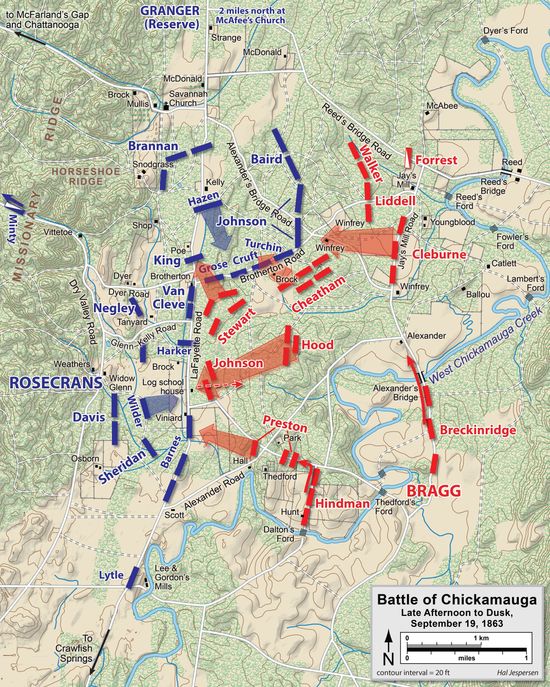
Left: US General William Rosecrans; Right CS General Braxton Bragg.
Today is the 150th anniversary of the first day of significant fighting at the Battle of Chickamauga, Georgia (some reckon 18 September as the first day). This battle would be one of the bloodiest of the western theatre of the Civil War, and served only to prolong the conflict in the west.
The Union Army of the Cumberland, 62,000 strong, under the command of US Major General William Rosecrans had, since the January fight around Murfreesboro, Tennessee, managed, in two stages, to secure the state of Tennessee with minimal loss. Mid-summer -- alongside the Battle of Gettysburg and the Siege of Vicksburg -- Rosecrans had secured Middle Tennessee with his rather brilliant, yet little known, Tullahoma Campaign (cf., http://thoscole.blogspot.com/2013/07/150th-of-tullahoma-campaign.html) which captured a great deal of ground with minimal loss.

The follow-up to the Tullahoma Campaign -- Rosecrans maneuvers for Chattanooga, August to September 1863. [Credit: Drawn in Adobe Illustrator CS5 by Hal Jespersen. Graphic source file is available at http://www.posix.com/CWmaps/]
General Rosecrans and the Army of the Cumberland would repeat the performance in the late summer, this time outmaneuvering the Confederate host to capture Chattanooga, Tennessee, without a fight on 9 September 1863.
Opposing him, though will something less than great success, was Confederate General Braxton Bragg and his reinforced CS Army of Tennessee, 65,000 in number. Bragg had received two notable additions to his force as the summer of 1863 came to a close: almost 18,000 men of CS General Simon Buckner's Department of East Tennessee, and, soon before the battle that we commemorate today, two divisions with CS General James Longstreet, detached from Robert E. Lee's Army of Northern Virginia.
While he may have been forced out of Tennessee without a fight, Bragg, now reinforced to a size comparable, even slightly larger than his foe, saw an opportunity to strike back at the widely dispersed Union force. US General Rosecrans, for his part, was perhaps a bit sanguine about his ability to simply keep forcing the Southerners back simply by a series of nearly bloodless flanking movements.

A fanciful rendering of the battle by Kurz & Allison.
It would be in North Georgia, along the banks of the Chickamauga Creek, that Bragg launched his attack. Rosecrans came to realize that his forces were vulnerable so widely dispersed -- part of his army was nearly trapped south of Chickamauga in McLemore's Cove. This clash at Davis's Cross Roads came on the 10 & 11 September 1863 -- click here for a description: http://www.cr.nps.gov/hps/abpp/battles/ga003.htm

The prelude battle -- Davis's Cross Roads, 11 September 1863, where Negley's force was nearly trapped in McLemore's Cove. Notice how dispersed the Union forces are a week before the fight at Chickamauga. [Credit: Drawn in Adobe Illustrator CS5 by Hal Jespersen. Graphic source file is available at http://www.posix.com/CWmaps/]
Rosecrans ordered his several Corps -- XIV Corps of George Thomas, his best subordinate, XX Corps of Alexander McCook, XXI Corps of Thomas Crittenden, the Reserve Corps of Gordon Granger, and the Cavalry Corps of Robert Mitchell -- to concentrate in an area along the banks of the Chickamauga Creek, south of Chattanooga.
For Bragg, his army was broadly divided into two "wings" each under the command of a Confederate Lieutenant General: the "right" under Leonidas Polk and the "left" under James Longstreet. Bragg intended to interpose his concentrated army between the Yankees and Chattanooga, and drive the Union force south, to corner and destroy them in some hollow -- McLemore Cove was ideal. When the armies first engaged, however, on 18 September, Bragg would find that the Union left was not where he envisioned. Flanking movements would become frontal assaults. The opening moves of the battle on the 18th saw the Southern troops force their way across Reed's Bridge at the northwest corner of what would be the battlefield.

Actions of late afternoon, 19 September 1863. [Credit: Drawn in Adobe Illustrator CS5 by Hal Jespersen. Graphic source file is available at http://www.posix.com/CWmaps/]
On 19 September 1863, after initial clashes the day before, the battle raged in earnest. Bragg initially had expected that he would be turning the left flank of the XXI Corps at Lee and Gordon's Mill on the Chickamauga, only to find the XIV Corps of Thomas in the way. A day of intense fighting followed, generally playing out from north to south on the battlefield. Particularly notable: the Confederate Division of CS General Stewart actually forced its way across the LaFayette Road in the center of the battlefield. Still, the Union lines would, at great cost, and with the timely arrival of US General Negley's Division, hold. The general assaults along the battle line were but a bloody prelude for the conclusive fight that unfolded the next day. For more, you can consult these splendid sites:
Chickamauga & Chattanooga National Military Park official site
NPS Battle Summary: Chickamauga
Civil War Home: Chickamauga Campaign (including official reports)
We shall conclude the battle tomorrow!
Live well!
No comments:
Post a Comment